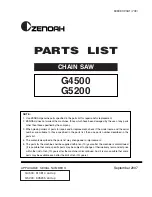
ADJUSTING THE TENSION
Chain tension is very important. Chains stretch during
use. This is especially true during the first few times
you use your saw. Always check chain tension each
time before you start the chain saw.
1. Loosen bar nuts until they are finger tight against
the clutch cover.
2.
Turn adjustment screw clockwise until chain solidly
contacts bottom of guide bar rail.
3. Using bar tool, roll chain around guide bar to
ensure all links are in bar groove.
4. Lift up tip of guide bar to check for sag. Release tip
of guide bar, then turn adjustment screw 1/4 turn
clockwise. Repeat until sag does not exist.
5.
While lifting tip of guide bar, tighten bar nuts
securely with the bar tool.
6. Use the screwdriver end of the bar tool to move
chain around guide bar.
7. If chain does not rotate, it is too tight. Slightly
loosen bar nuts and loosen chain by turning the
adjustment screw 1/4 turn counterclockwise.
Retighten bar nuts.
8.
If chain is too loose, it will sag below the guide bar.
DO NOT operate the saw if the chain is loose.
NOTE: The chain is tensioned correctly when
the weight of the chain does not cause it to sag
below the guide bar (with the chain saw sitting in
an upright position), but the chain still moves freely
around the guide bar.
a
WARNING: If the saw is operated with
a loose chain, the chain could jump off
the guide bar and result in serious injury
to the operator and/or damage the chain
making it unusable. If the chain jumps off
the guide bar, inspect each drive link for
damage. Damaged chain must be repaired
or replaced.
FUEL HANDLING
FUELING ENGINE
a
WARNING: Remove fuel cap slowly when
refueling.
IMPORTANT: This equipment is designed to operate
on unleaded gasoline with a minimum 87 octane (AKI),
with ethanol blended up to 10% maximum by volume
(E-10). Before operation, gasoline must be mixed with
a good quality synthetic 2-cycle air-cooled engine oil
designed to be mixed at a ratio of 50:1.
DO NOT USE automotive oil or marine oil. These oils
will cause engine damage. When mixing fuel, follow
instructions printed on container. Once oil is added to
gasoline, shake container momentarily to assure that
the fuel is thoroughly mixed. Always read and follow
the safety rules relating to fuel before fueling your unit.
Purchase fuel in quantities that can be used within 30
days to assure fuel freshness.
CAUTION: Never use straight gasoline in your unit.
This will cause permanent engine damage and void
the limited warranty. Do not use alternate fuels such
as ethanol blends above 10% by volume (E-15,
E-85) or any methanol blended fuel. Use of these
fuels can cause major engine performance and
durability problems.
Gasoline, gallons
Two-stroke oil, ounces
1
2.6
2
5.2
5
13
10
26
BAR AND CHAIN LUBRICATION
The bar and chain require continuous lubrication.
Lubrication is provided by the automatic oiler system
when the oil tank is kept filled. Lack of oil will quickly
ruin the bar and chain.
Too little oil will cause overheating shown by smoke
coming from the chain and/or discoloration of the
bar. In freezing weather oil will thicken, making it
necessary to thin bar and chain oil with a small
amount (5 to 10%) of #1 Diesel Fuel or kerosene. Bar
and chain oil must be free flowing for the oil system to
pump enough oil for adequate lubrication.
Bar and chain oil is recommended to protect your unit
against excessive wear from heat and friction. If bar
and chain oil is not available, use a good grade SAE
30 oil.
•
Never use waste oil for bar and chain lubrication.
•
Always stop the engine before removing the oil cap.
8









































